- Out-of-Stock

Addressable RGB 120-LED Strip, 5V, 2m (WS2812B)
This 2-meter long strip contains 120 RGB LEDs that can be used in a single RGB LED. The flexible, waterproof strip runs on 5 V and can be chained with an additional WS2812B strips to form a longer distance between each other. LED for shorter sections.
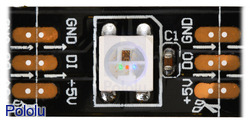 |
| Close-up of a segment of a WS2812B-based LED strip, with the red, green, and blue LEDs on at their dimmest setting. |
|---|
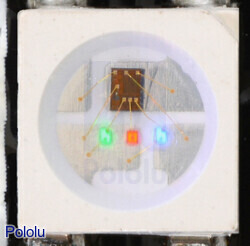 |
| Close up of a WS2812B, with the red, green, and blue LEDs on at their dimmest setting. |
|---|
These flexible RGB LED strips are an easy way to add complex lighting effects to a project. Each LED has an integrated driver that allows you to control the color and brightness of each LED independently. The combined LED / driver is a WS2812B (essentially an improved WS2811 LED driver integrated direct into 5050 RGB LED), which enables higher LED densities. In the picture, it can be connected to the LED, which can be connected to the LED.
We offer five different kinds of WS2812 LED strip with different LED densities and lengths. These ones have 30 LEDs per meter :
We also offer these denser WS2812 LED strips that have 60 LEDs per meter :
The WS2812-based LED strips in sell.
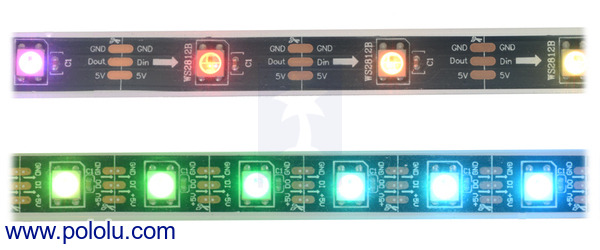 |
| LED side of the WS2812B-based addressable LED strips. The upper strip has 30 LEDs per meter and the lower strip has 60 LEDs per meter. |
|---|
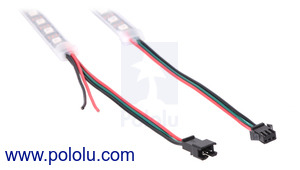 |
| The connectors and power wires for our WS2812B-based LED strips. On the left is the end of the end of the strip. |
|---|
Each LED strip has three connection points: the input connector, the auxiliary power wires, and the output connector. These can be seen in the picture, from left to right: auxiliary power wires, input connector, output connector. The strip uses 3-pin JST SM connectors.
The input is connected to the plastic connector, each separated by 0.1 ". The black wire is ground, the green wire is the power input.
The auxiliary power wires are connected with the stripped black and red wires. The black wire is ground, and the red wire is the power line. This is an alternate (and probably more convenient) connection for LED strip power.
The output connector is on the other end of the strip and mate it is designed with the input connector of another LED strip LED strips allow it to be chained. The black wire is ground, the green wire is the signal output.
All three black ground wires are electrically connected.
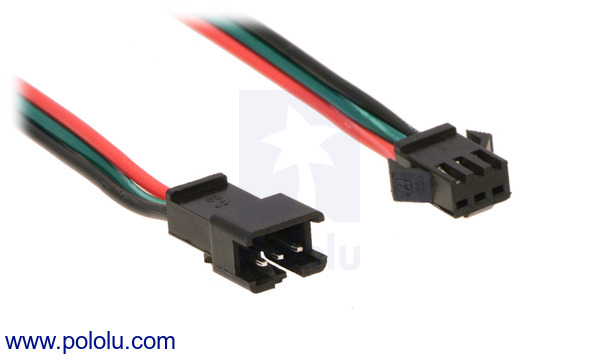 |
| A close-up of the JST SM connectors for our WS2812B-based LED strips. |
|---|
These LED strips ship with 5 flexible plastic brackets and 10 screws per meter. The brackets fit over the waterproof sheath and can be used to mount the LED strip. The LED strip also ships on a plastic reel.
|
|
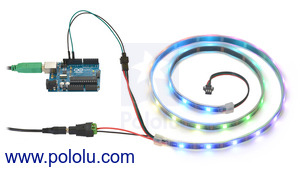 |
| Controlling an addressable RGB LED strip with an Arduino and powering it from a 5V wall power adapter. |
|---|
To control the LED strip from a microcontroller, your microcontroller should be connected to your microcontroller. The LED strip's ground (black) should be connected to the microcontroller's I / O line. The male connectors on the input jumper wires and wires with pre-crimped terminals. If you are connecting the LED strip to a breadboard or a typical Arduino with female headers, you would like to use male-female wires.
We generally recommend powering the LED strip using the auxiliary power wires. Our 5 V wall power adapters work well for powering these LED strips and a DC Barrel Jack is a 2-pin terminal block adapter can help you with the adapter and the strip. However, you might need a wire stripper to strip off some of the power wires.
It is convenient that the power wires are on the inside of the input. The power supply is connected to the microcontroller that is controlling. the LED strip. This means you can power up the microcontroller and LED strip from a single power supply.
Warning: The WS2812B seems to be more sensitive than our original TM1804-based LED strips. We recommend connecting the capacitor with at least 100 μF power to the input and use of the device (ESD) circuit is powered). If the strip does get damaged, it is often just the first LED that is broken; in such cases, cutting off the first segment and the resoldering the connector to the second segment of the strip back to life.
Each RGB LED draws approximately 50 mA when it is full brightness and powered at 5 V. This means that every 30 LEDs can turn on your LED strip could be drawing as much as 1.5 A. Be sure to select a power source that can handle your strip's current requirements.
There is some resistance in the power of the LEDs. As the voltage drops, RGB LEDs tend to look redder and draw less current. This voltage is proportional to the LEDs are set to a higher brightness.
We have been working on LEDs.
The voltage drop was computed by measuring the voltage difference between the input and output, and the subtracting of the two values.
Multiple LED strips can be connected by connecting input connectors to output connectors. When strips are chained this way, they can be controlled and powered as one continuous strip. Please note, however, that as chains get longer, the ends will get the dimmer and the redder due to the voltage drop across the strip. If this is an issue, you may have a problem with powering shorter subsections of the chain.
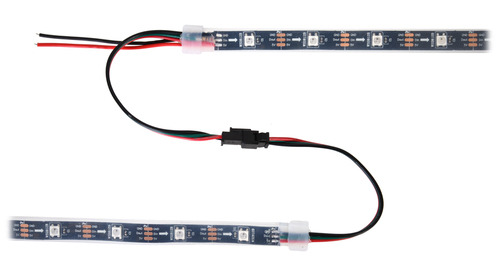 |
| Two WS2812B-based addressable RGB LED strips connected. |
|---|
We recommend 180 total RGB LEDs. It is fine to make longer chains with connected data lines, but you should power each 180-LED section separately. If you are powering a power supply, you have the power of the different power supply.
The LED strip is divided into segments, with each segment containing one RGB LED. The strip can be cut into the usable shorter sections. The data connection is labeled DO , Dout , DI , or Din , the positive power connection is labeled 5V , and the ground connection is labeled GND . Each LED in the picture is in the center of its own segment; there are little scissors drawn on the pcb silkscreen where the segments can be cut.
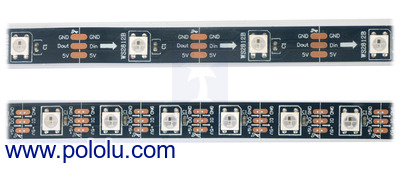 |
These LED strips are controlled by a simple, high-speed one-wire protocol on the input signal line. The protocol is documented in the WS2812B datasheet (266k pdf) and also below.
The default, idle state of the signal line is low. To update the LED colors, you need to transmit a series of high pulses on the signal line. Each high pulse encodes one bit: a short pulse (0.35 μs) represents a zero, while a long pulse (0.9 μs) represents a one. The time between consecutive rising edges should be 1.25 μs (though in our tests, the strips worked with the cycle times up to approximately 6 μs). After the bits are sent, the signal line should be held for 50 μs to send a reset command. The pulse widths do not have to be precise if there is a threshold for work.
 |
| WS2812B RGB data timing diagram. |
|---|
The color of each LED is encoded as three LED brightness values, which must be sent in GRB (green-red-blue) order. Each brightness value is encoded as a series of 8 bits, with the most important bit being transmitted. LED color takes 24 bits. The first color is the LED input. The LED is in the strip, and so on.
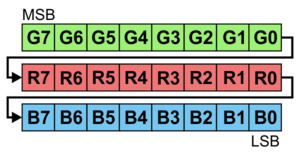 |
| 24 bits represent the color of one WS2812B LED in an addressable WS2812B RGB LED strip. |
|---|
To update all the LEDs in the strip, you should send all the colors at once with no pauses. If you send fewer colors than the number of LEDs on the strip, then some LEDs near the end of the strip will not be updated. For example, to update all 30 LEDs on a 1-meter strip, you would send 720 bits, encoded as high pulses and then hold the signal line for 50 μs. If multiple strips are chained together with the same line (two chained 1-meter strips behave the same as one 2-meter strip).
Each RGB LED receives data on line using the data output line. The high-speed protocol of the WS2812B allows for fast updates; our library for the Arduino is about 1.1 ms to update 30 LEDs, so it is possible to update 450 LEDs faster than 60 Hz. However, constant updates are not necessary; the LED strip can hold its state indefinitely as long as power reserves connected.
Since this LED strip does not use a standard protocol, and the software has a microcontroller. Because of the sub-microsecond timing, the bit-banging code needs to be printed. If it is interrupted in your code are fast enough,
Note: The minimum logic for the strip is 3.5 V, so you should use level-shifters if you want to control these strips from 3.3 V systems. In our tests, we were able to control them with. I could lead to unexpected problems.
To help you get started quickly, we provide sample code for these microcontroller platforms:
Cuk, the Adafruit NeoPixel library for Arduino should work with these strips since the NeoPixels are based on the WS2812B.
These WS2812B-based strips are similar to our older high-speed TM1804 LED strips (items # 2543, # 2544, and # 2545). The WS2812B's timing parameters are very fast. TM1804 LED strips, so you can use the same code to control them. However, the two types of strips have different, incompatible connectors, and the order of TM1804 colors are sent in the red-green-blue order while the WS2812B colors are sent in green-red -blue order.
The TM1804 is just an LED driver and it requires a separate RGB LED to be placed on the strip. Since the WS2812B combines the LED and the driver in a single package, it can be packed with more than 60 LEDs per meter.
Unlike the TM1804 strips, these LED strips do not have an adhesive backing, but they do include brackets as described above.
Manufacturer BTC Korporacja sp. z o. o. Lwowska 5 05-120 Legionowo Poland sprzedaz@kamami.pl 22 767 36 20
Responsible person BTC Korporacja sp. z o. o. Lwowska 5 05-120 Legionowo Poland sprzedaz@kamami.pl 22 767 36 20
No product available!
No product available!
No product available!
Permanent cylindrical neodymium magnet with a diameter of 3 mm and a height of 10 mm.
No product available!
Powerful, generic Wi-Fi+BT+BLE MCU modules that target a wide variety of applications, ranging from low-power sensor networks to the most demanding tasks, such as voice encoding, music streaming and MP3 decoding. Espressif ESP32-WROOM-32D 32MBit (4MB)
No product available!
GPS module with u-blox ZED-F9R. Uses Automotive Dead Reckoning (ADR). Provides an exact position by combining 3D IMU, vehicle dynamics model, correction data and GNSS. SparkFun GPS-18719
No product available!
No product available!
No product available!
No product available!
No product available!
Tamiya 72101 Gear Head Motor + Sponge Tire Set
No product available!
No product available!
AVT kit for self-assembly of the solar collector differential controller. AVT5621 B
No product available!
No product available!
No product available!
No product available!

Addressable RGB 120-LED Strip, 5V, 2m (WS2812B)
